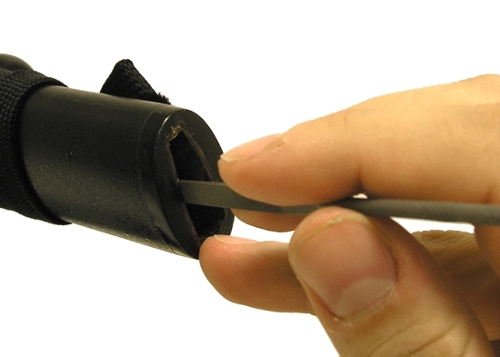Tight and Loose Saya Fixes 101
A loose saya, or an overly tight one, is not at all an uncommon thing - especially at during Winter and Summer time, when variations in heat, barometric pressure and a host of other environmental factors can cause the wooden sheathe to tighten up or become loose.
Contrary to popular belief, most sword sellers DO check the fit before shipping, but along the way the sword is rapidly exposed to all kinds of sudden temperature changes that historical swords never had to deal with. And over time, repeated drawing and sheathing of the sword will also result in a loose saya as the wood is slowly worn away.
As such, learning how to shim a loose saya or adjust an overly tight one is a necessary skill for anyone who uses their sword. Luckily, it is nowhere near as hard to do as it sounds..
The Easiest Fix and the First Thing to Try...
Before you take action to fix a tight or loose saya, the first thing to consider is that the wood has reacted to the journey to get to you. In conditions drier and/or colder than where it first started its voyage, the wood shrinks and the saya becomes tight as the moisture inside it evaporates.
Conversely, in a humid environment, the cells of the wood absorb moisture from the air and expand, creating a loose saya.
As such, before doing anything to adjust it, it is advisable to change the conditions where the sword is stored for a week or two. If it is too tight, place it near a humidifier and it should expand and become easy to draw again. If it is too loose, place it in the driest place possible and it should tighten up naturally.
Quite often just changing the environment where the sword is stored for a few week or so is all that is needed to fix the problem.
It can be maddening for everyone involved when a sword arrives loose, is sent back to the vendor, and they say its fine and send it back, only to have it arrive loose again..! No one is lying in this situation, the saya is just expanding and contracting to annoy everyone (so it seems) and contrary to some people's suspicions, most sellers never knowingly send out a sword that they know has a a loose or impossible to draw saya..
Fixing a Tight Saya

If changing the saya to a more humid, moist area doesn't work after a week or two - then you may need to file the inside of the koiguchi.
This is the mouth of the saya, and is the tightest part of the assembly, so removing just a little of the wood with a small file is usually enough to give it a perfect fit. You can identify which are the high parts you need to file down by looking at any marks on your habaki (the brass blade collar that mates with the saya). If it still sticks, check as you go by re-sheathing the sword to see what area is pinching it the most.
One additional technique is to simply spend time repeatedly popping the blade in and out of the saya to wear it down as you watch TV. This will accelerate loosening, and after a few hundred pops in and out may well have loosened enough to be drawn easily again.
Fixing a Loose Saya
As we noted, a loose saya is often the result of humidity causing the saya to swell - so one easy fix to try first is to place it in a warm, dry place wrapped up with some silica gel, which as you know is a desiccant and will help absorb the excess moisture causing it to swell.
If this fails, or the saya has become loose from repeated drawing and sheathing rubbing away the material inside the koiguchi, then it will need to shimmed. To shim the saya, you will need a little wood veneer (available at any home store, lumber yard, and if it does not have an adhesive on one side, some glue (Elmers, wood glue, anything will do)
 Wood Veneer
Wood VeneerAll you need to do is stick it into the mouth of the koiguchi, let it dry and it should have tightened the saya back up again.

More detailed instructions can be found here at the Cas Iberia website - it was such a common issue that at one point they included this instruction sheet with every single sword they sold regardless of price (wood often doesn't know how much it costs you know)..
Here is a quick video tutorial which shows you the same technique.
But before you do anything, give the wood a chance to breathe and adjust. Shimming or opening the fit of the koiguchi is often not needed if you simply allow the saya a little time to return to a good fit - and nothing is more annoying to shim a saya and then find that it has shrunk and a few weeks later is impossible to draw..
I hope this information on how to fix a tight or loose saya has been helpful. To return to Sword Care and Maintenance 101 from Tight and Loose Saya Fixes 101, click here

Buying Swords Online Can Be DANGEROUS!
Find the Best Swords in the:
Popular & Recommended ARTICLES

The ONLY true free online magazine for sword enthusiasts. Delivered once a month on the 1st day of the month, no filler and no BS, just the latest sword news & info delivered straight to your inbox.













